Excerpts from Jim Conrad's
Naturalist Newsletter
from the July 3, 2016 Newsletter with notes from a visit to Lacanja Chansayab in the Lacandon Reserve; elevation 200m (650ft), N16.604°, W90.917°; Chiapas, MÉXICO
BRAZILIAN FERN TREE
In mid April when I was in the Lacandon community of Lacanja Chansayab in Chiapas's Lacandon Reserve in extreme southeastern Mexico, inside the Reserve where forest destruction wasn't as bad, often I saw a roadside tree I remembered from traveling in the area years ago, but which doesn't appear in the Yucatan because it's too dry there. The trees averaged 15-20ft tall (5-6m) and the eye-catching thing about them was their unusual shape. They were like giant umbrellas -- tall, slender, unbranching trunks topped with widely spreading, ferny-looking leaves. Below, you can see the tops of some:
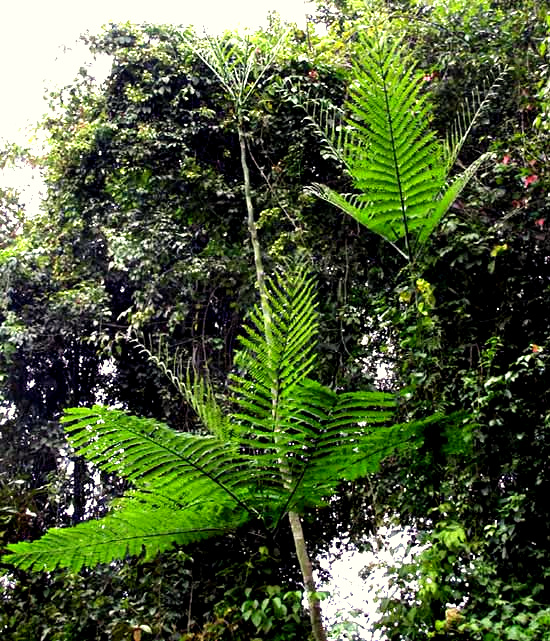
The leaves themselves are remarkable, as seen closer up below:
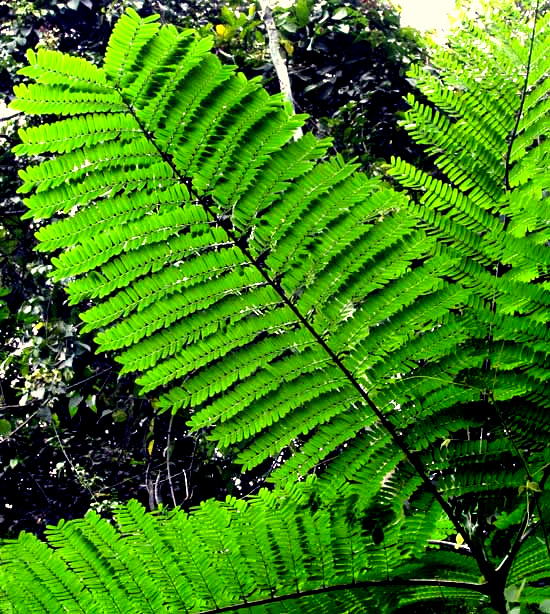
They're about a yard long (1m) and doubly pinnately compound, like acacia leaves, and thus fairly typical of many members of the Bean Family, the Fabaceae, to which the species belongs. Unfortunately the trees bore neither flowers nor fruits, but I figured that with such unusual leaves I might figure out the trees' identity anyway, and that was the case.
They're SCHIZOLOBIUM PARAHYBA, sometimes known as Brazilian Fern Trees, despite their being native from southern Mexico south through Central America to southern Brazil. The "fern" part of the name refers to the species' similarity to tree ferns.
Brazilian Fern Trees can grow seven feet a year (2m). In Brazil an eight year old tree already had grown over 40ft tall (12.5m). Largely because they're such unusual looking trees, they're planted in the tropics and subtropics worldwide, even in southern California. During a brief part of the tree's life cycle it issues large clusters of cassia/senna-type, yellow flowers. Older trees develop branches and take on a somewhat gangling look. However, at the forest's edge, they definitely lend the landscape a wild, primitive look.
from the April 20, 2019 Newsletter with notes from a camping trip into northern Guatemala's Petén department
BRAZILIAN FERN TREES FRUITING
Earlier this month, on April 1, I was following trails between Maya ruins in the extensive Ceibal Archaeological Park about 15kms east of Sayaxché. The trails were cut through dense forest, and were developed atop thin soil derived from white limestone. In one place the ground was littered with flattish, club-shaped, legume-type fruits -- a mixture of green, recently fallen ones and older, brown, decaying ones -- as shown below:
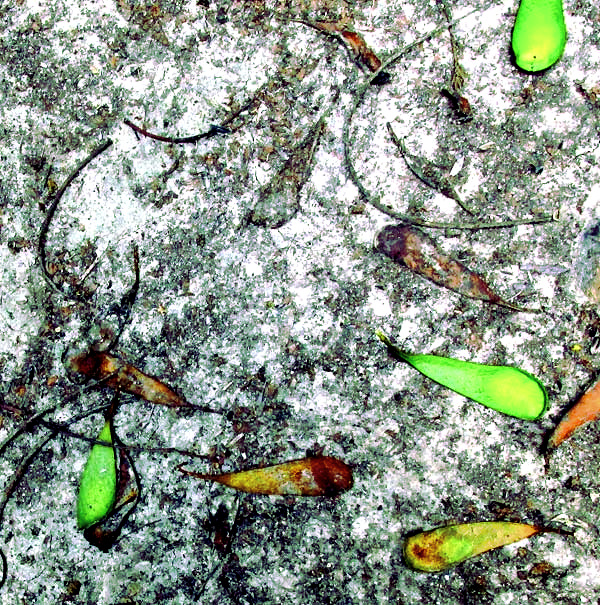
A close-up of a 10cm long legume (4 inches) is seen below:
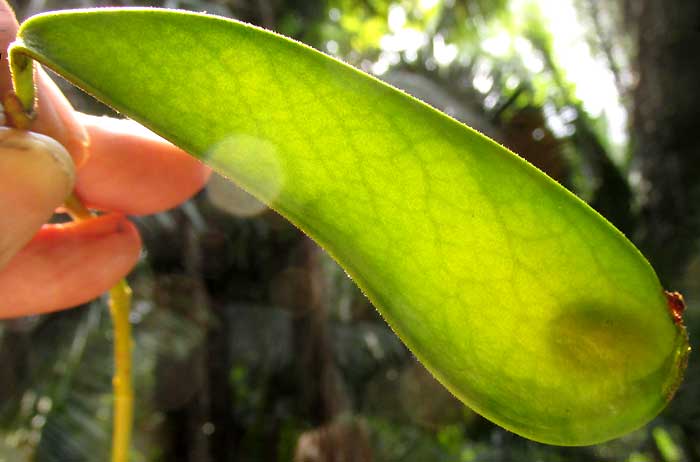
A legume is a simple fruit splitting along both margins, and derived from an ovary with only one cell, or carpel. When you find a legume like this, think "Bean Family." The vast majority of Bean Family species produce legumes with more than one seed, or bean, but this and all other legumes seen that day on the forest floor contained only one bean, so here was an important field mark for identifying the plant the legumes fell from. The forest canopy above that spot in the trail was dominated by a single large tree, mostly leafless now toward the end of the dry season, shown below:
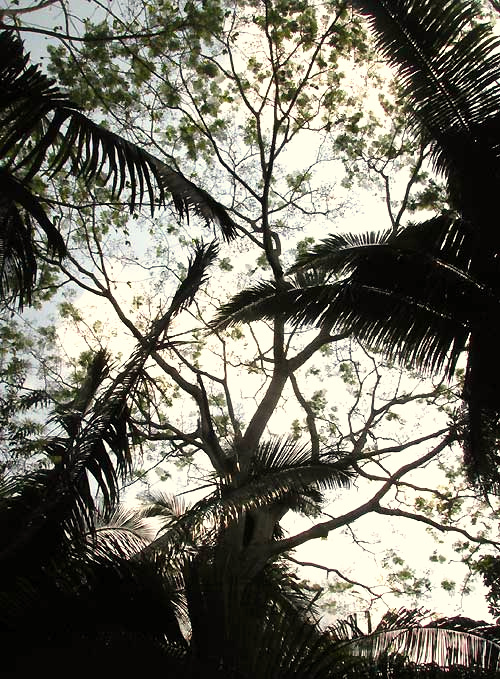
The tree's branches were too high to see whether they bore fruits like those on the ground, but the camera's little telephoto lens zoomed to its maximum settled the issue by revealing what's seen below:
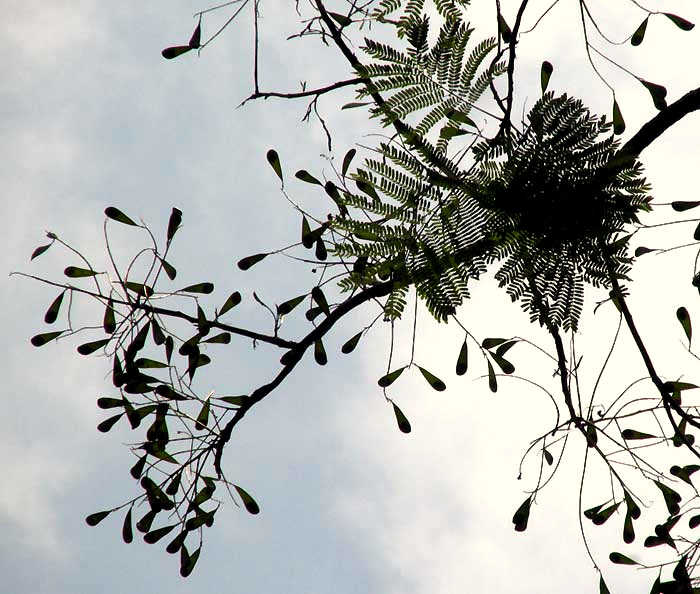
That picture also shows a few of the big tree's leaves, which seemed to be emerging in anticipation of the first rains. They were twice pinnately compound, like the Bean Family's acacia and mimosa leaves.
All these distinctive field marks led to a species we've already seen, but looking very different. It's the Brazilian Fern Tree, Schizolobium parahyba, introduced above. There, leaves on young trees are so big, over 2m long (6½ft), that the trees look like tree ferns. Leaves on the tree above our trail in Guatemala appear to be much smaller. My impression is that young, fast-growing trees bear larger leaves than do mature trees, though the scale of things high in a forest canopy is hard to determine.
The literature promises us yet a third spectacular appearance of the Brazilian Fern Tree -- when it's flowering. Apparently then it looks like a gigantic, brightly yellow, upside-down feather-duster.